Swedish America
-
- With an Interceptor, a RHIB and a Cat Maritime Reporter, Mar 2014 #40
Two extreme AC72 foiling catamarans with wing sails went head-to-head at over 40 knots in San Francisco Bay, California. The teams were competing in the 2013 Americas Cup Challenge which took place from September 7-21, 2013.
Anyone watching the first few days of Americas Cup sailing will know that it looked like Emirates Team New Zealand had a seemingly untouchable lead – then out of the blue Oracle Team USA completed one of the greatest comebacks in sport to win the 34th America’s Cup. For anyone who has watched the rising speeds of sailing records plus the development of hydrofoil technology, this event was also bound to be a game changer for ‘power versus sail.’ Another race was on in San Francisco Bay as Chase Boats and Umpire Boats utilized gasoline and diesel engine horsepower versus the AC72 boats utilizing wind energy, aerodynamics and hydrodynamics.
The AC72 is a state-of-the-art design wind powered craft. Overall length is 86 ft. (26 m), waterline length is 72 ft. (22 m) and it has an extraordinary beam of 46 ft. (14 m). The boat only weighs 13,000 pounds (5900 kg), it has a maximum draught of 14 feet (4.4 m) and is handled by a crew of eleven.
The AC72 rises out of the water on foils and designers always expected it to sail faster than the wind. Predictions were upwind at 1.2 times the speed of the true wind and downwind at 1.6 times the speed of the true wind. But the AC72 has proved to be faster, averaging about 1.8 times the speed of the wind, with peaks slightly over 2.0 times the speed of the wind. The extreme foiling catamaran design means that AC72 racing takes place on the edge of control.
There is potential for crews to fall overboard or to require immediate attention in case of injury. Each team is allowed a Chase Boat and to provide a margin of safety these high speed craft need to not only match the race boat speeds, but to be able to exceed them.
With the wing mast / sail set up if a crew breaks something, they can’t just turn and go home, because the wing stays loaded up.
The support boat has to be able to tow an AC72 home faster than the wind speed, which can mean towing at 25 knots. The boat also needs the puling power to be able to right an AC72 after a capsize – fast.
The crews try to avoid the dangers of a capsize but it is a possibility that support teams must plan for.
Tragically in May 2013, British Olympic sailing champion Andrew ‘Bart’ Simpson died after the Swedish America’s Cup craft he was sailing capsized and broke apart in San Francisco Bay. Simpson, a 36-year-old two-time Olympic medallist, suffered multiple blows to his head and body in the accident involving the 72-ft. Artemis Racing catamaran. The San Francisco medical examiner’s report said, ‘In the moments before it capsized, the yacht was turning downwind in a so called bear-away manoeuvre while travelling at about 30 knots, with wind of about 20 knots. The front of the vessel then dipped beneath the surface, the port hull broke and inverted on top of the wing.’Most conventional power craft cannot fulfill the demanding task of supporting the 72-ft. Americas Cup catamarans that can accelerate to 40 knots in seconds. The power boat ride quality has to allow for keeping up with an AC72 for an entire day, regardless of how fast the sail boat is going or what the sea conditions are like. The objective is to have a high speed craft that does not fatigue the crew and keeps the team’s paramedic and dive crews ready for action.
This is high stakes racing with multi-million dollar investments by owners and sponsors. With money of less object than usual it is interesting to compare the various designs that the teams selected as Chase Boats. The racers also require a high performance Umpire Boat capable of following close to the action and providing instant visuals of the competition as it unfolds.
The Offshore Interceptor - America’s Cup Umpire Boat
A Willard Marine High Speed Interceptor was chosen by the Americas Cup Racing Association as the Umpire Boat for the 2013 Americas Cup. The 43-ft. (13 m) craft is powered by twin Cummins 600 hp inboard diesel engines and surface drive system. The Interceptor was developed for military use from a Scarab offshore racing design and can achieve speeds greater than 60 knots.
Willard Marine teamed up with Larry Smith of Team Scarab to develop the design. Team Scarab has a 30-year heritage of designing and building world champion offshore race boats. The Interceptor was initially prototyped in response to a request by the U.S. Navy for a high-speed combat mission boat. The 43 Assault is also ideal for intercepting and boarding boats and vessels in the open ocean. Willard worked closely with Team Scarab to refine their Deep V stepped hull design in order to meet the U.S. Navy requirements, including shock mitigation seats and light weight engines. The Interceptor also has a Supplemental Stability System (S3) that increases the stability, passenger comfort and safety of heavily loaded high speed craft. The variable geometry of the sponsons increases hull efficiency and aft buoyancy where the fuel, engine and passenger loads are.
The Rigid Hull Inflatable Boat - Oracle Racing Team USA Chase Boat
Naiad Inflatables of Newport produced two custom built 42-ft. (12.9 m) RHIBs for Oracle Racing Team USA to support the Defender AC72 Yachts. Twin Yanmar 370hp inboard engines allow the chase boat to maintain the power, agility and endurance required to support the yachts through the variable conditions of San Francisco Bay at up to 45 knots.
Naiad has a strong legacy of involvement in the Americas Cup, dating back to tenders produced for Challenge New Zealand for the 1992 event in San Diego. Naiad was the first company to develop a RHIB more than 40 feet specifically designed to carry the large fully battened mainsails, unique at the time to the IACC class of Americas Cup race yachts.
These vessels were used by Team New Zealand, which successfully challenged for and won the Americas Cup in 1995 and successfully defended the Americas Cup in 2000. In addition to Team New Zealand, two of the challengers had Naiad boats custom built for the 2000 Americas Cup. The 46-ft. (14 m) Naiad Ranger was the first shaft driven inflatable, she was custom built to tow two of Young Americas IACC yachts simultaneously. This platform spawned a whole new class of diesel shaft commercial RHIB vessels for towing and pilot boat use.
High Speed Catamaran - Emirates Team New Zealand Chase Boat
Morrelli & Melvin designed a 45-foot (13.7 m) 1,200 hp high-speed catamaran as Tender and Chase Boat for Emirates Team New Zealand AC72. The concept was developed in collaboration with ETNZ and Salthouse Boatbuilders. The ETNZ chase boat is powered by four 300hp Yamaha V6 four-stroke outboard engines and has a top speed of 58 knots.
The fiberglass hull is topped with inflatable tubes allowing it to slip in beside the AC72. The ETNZ boat includes a protected main deck cabin, head, and large storage area under the foredeck. The craft has four engines to deliver the power needed to right a capsized AC72. Running all four engines at 3,000 rpm gives 30 knots and the boat uses 100 liters of fuel an hour. The boat holds 1,700 liters of fuel which gives a range of 510 nautical miles or 17 hours running time at 30 knots.
Sitting On The Dock Of The Bay
Chris Sitzenstock gave an overview of conditions onboard the Oracle Team USA Chase Boat, “the sea state in the Bay was really everything you can imagine. A few miles outside the Golden Gate to the South Bay it can go from square six to eight-ft. waves to a mill pond. The Bay is very consistent for wind, waves and ground swell funneling through the Golden Gate Bridge. Wash from the spectator boats did not have a great effect on the race course as the Bay is so busy with commercial traffic and ferries. The particularly bad sections were usually combinations of wind against tide.”
We asked Chris whether protecting equipment (mechanics / electrical / cameras) was a reason to slow down. He replied, “the Chase Boats have to follow the racing yachts so if the equipment could not take it we had to improve equipment. We asked Chris whether protecting the human body was a reason to slow down. He replied, “the Chase Boats have to follow the racing yachts so if the human body could not take it we had to improve the human body.”
There is plenty that the military and professional fast boat sector can learn from this unique situation where craft are pushed to the limit for days and weeks. Congratulations to all the racers and support teams that made the 2013 Americas Cup an outstanding event and raised the bar for power versus sail.
The Author
John Haynes, AFNI, is a Yachtmaster Ocean and Advanced Powerboat Instructor. Subject matter expertise includes high speed craft consultancy, product development and specialist training. He is Operations Director of Shock Mitigation and founder of the RIB & High Speed Craft Directory that brings together specialist boats and equipment for the professional sector
www.ribandhsc.com(As published in the March 2014 edition of Maritime Reporter & Engineering News - www.marinelink.com)
-
 )
April 2024 - Maritime Reporter and Engineering News page: 38
)
April 2024 - Maritime Reporter and Engineering News page: 38Tech Files Latest Products, Systems and Ship Designs Zero-Emission Mooring Service of a Tanker Consulmar achieved a milestone by executing what it calls ing boat Castalia, which operates on full electric propulsion. the world's ? rst zero-emissions mooring service for a tanker. Equipped with two 150 kW
-
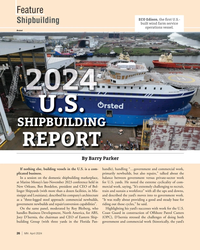 )
April 2024 - Marine News page: 26
)
April 2024 - Marine News page: 26Feature ECO Edison, the ? rst U.S.- Shipbuilding built wind farm service operations vessel. Ørsted U.S. SHIPBUILDING REPORT By Barry Parker If nothing else, building vessels in the U.S. is a com- handle), handling “…government and commercial work, plicated business. primarily newbuilds, but also
-
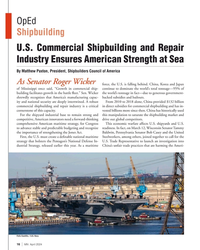 )
April 2024 - Marine News page: 16
)
April 2024 - Marine News page: 16OpEd Shipbuilding U.S. Commercial Shipbuilding and Repair Industry Ensures American Strength at Sea By Matthew Paxton, President, Shipbuilders Council of America As Senator Roger Wicker force, the U.S. is falling behind. China, Korea and Japan of Mississippi once said, “Growth in commercial ship-
-
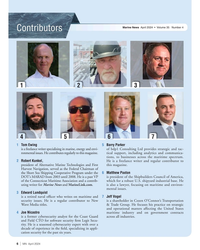 )
April 2024 - Marine News page: 6
)
April 2024 - Marine News page: 6Marine News April 2024 • Volume 35 Number 4 Contributors 1 2 3 5 4 6 7 1 Tom Ewing 5 Barry Parker is a freelance writer specializing in marine, energy and envi- of bdp1 Consulting Ltd provides strategic and tac- ronmental issues. He contributes regularly to this magazine. tical support, including
-
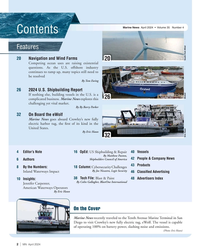 )
April 2024 - Marine News page: 2
)
April 2024 - Marine News page: 2Marine News April 2024 • Volume 35 Number 4 Contents Features 20 Navigation and Wind Farms 20 Competing ocean uses are raising existential questions. As the U.S. offshore industry continues to ramp up, many topics still need to be resolved By Tom Ewing 26 2024 U.S. Shipbuilding Report If
-
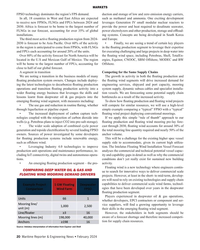 )
February 2024 - Maritime Reporter and Engineering News page: 20
)
February 2024 - Maritime Reporter and Engineering News page: 20MARKETS FPSO technology dominates the region’s FPS demand. duction and storage of low and zero emission energy carriers, In all, 18 countries in West and East Africa are expected such as methanol and ammonia. One exciting development to receive new FPSOs, FLNGs and FPUs between 2024 and leverages
-
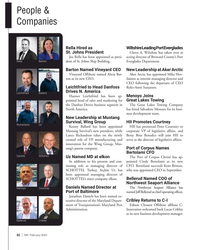 )
February 2024 - Marine News page: 42
)
February 2024 - Marine News page: 42People & Companies Rella Hired as Wiltshire Leading Port Everglades St. Johns President Glenn A. Wiltshire has taken over as Joe Rella has been appointed as presi- acting director of Broward County’s Port Rella Barton dent of St. Johns Ship Building. Everglades Department. Barton Named Vineyard CEO New
-
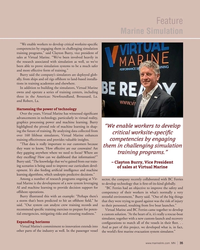 )
February 2024 - Marine News page: 35
)
February 2024 - Marine News page: 35Feature Marine Simulation “We enable workers to develop critical worksite-speci? c competencies by engaging them in challenging simulation training programs,” said Clayton Burry, vice president of sales at Virtual Marine. “We’ve been involved heavily in the research associated with simulation as well
-
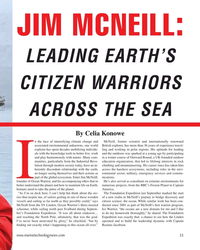 )
January 2024 - Marine Technology Reporter page: 35
)
January 2024 - Marine Technology Reporter page: 35JIM MCNEILL: LEADING EARTH’S CITIZEN WARRIORS ACROSS THE SEA By Celia Konowe n the face of intensifying climate change and McNeill, former scientist and internationally renowned associated environmental unknowns, one world British explorer, has more than 36 years of experience travel- explorer has
-
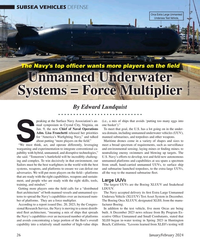 )
January 2024 - Marine Technology Reporter page: 26
)
January 2024 - Marine Technology Reporter page: 26SUBSEA VEHICLES DEFENSE Orca Extra Large Unmanned Undersea Test Vehicle. The Navy’s top of? cer wants more players on the ? eld Unmanned Underwater Systems = Force Multiplier Source: Boeing By Edward Lundquist peaking at the Surface Navy Association’s an- (i.e., a mix of ships that avoids ‘putting too
-
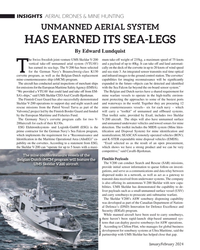 )
January 2024 - Marine Technology Reporter page: 12
)
January 2024 - Marine Technology Reporter page: 12INSIGHTS AERIAL DRONES & MINE HUNTING UNMANNED AERIAL SYSTEM HAS EARNED ITS SEA-LEGS By Edward Lundquist he Swiss-Swedish joint-venture UMS Skeldar V-200 mum take-off weight of 235kg, a maximum speed of 75 knots vertical take-off unmanned arial system (VTUAV) and a payload of up to 40kg. It can take
-
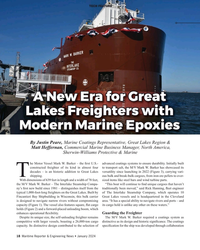 )
January 2024 - Maritime Reporter and Engineering News page: 18
)
January 2024 - Maritime Reporter and Engineering News page: 18TECH FEATURE A New Era for Great Lakes Freighters with Modern Marine Epoxies By Justin Peare, Marine Coatings Representative, Great Lakes Region & Matt Heffernan, Commercial Marine Business Manager, North America, Sherwin-Williams Protective & Marine he Motor Vessel Mark W. Barker – the ? rst U.S.
-
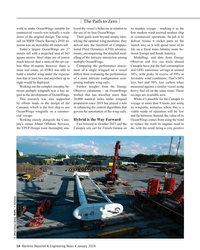 )
January 2024 - Maritime Reporter and Engineering News page: 14
)
January 2024 - Maritime Reporter and Engineering News page: 14The Path to Zero work to make OceanWings suitable for lyzed the vessel’s behavior in relation to its maiden voyage – marking it as the commercial vessels was actually a scale the use of its four OceanWings. ? rst modern wind assisted modern ship down of the original design. The wing- Their goals went
-
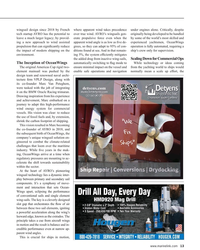 )
January 2024 - Maritime Reporter and Engineering News page: 13
)
January 2024 - Maritime Reporter and Engineering News page: 13wingsail design since 2018 by French where apparent wind takes precedence under engines alone. Critically, despite tech startup AYRO has the potential to over true wind. AYRO’s wingsails gen- originally being developed to be handled leave a much larger legacy; by provid- erate propulsive force even
-
 )
January 2024 - Maritime Reporter and Engineering News page: 12
)
January 2024 - Maritime Reporter and Engineering News page: 12The Path to Zero © Jifmar Group Library Americas Cup Innovation & a Carbon-Free Shipping Future By Giorgio PROVINCIALI, CTO of AYRO and Former America’s Cup Performance Predictions Leader he Golden Gate Yacht Club sign, all of which were changed by the success in bringing the Americas Cup (GGYC)
-
 )
January 2024 - Maritime Reporter and Engineering News page: 4
)
January 2024 - Maritime Reporter and Engineering News page: 4Authors & Contributors MARITIME REPORTER AND ENGINEERING NEWS M A R I N E L I N K . C O M ISSN-0025-3448 USPS-016-750 No. 1 Vol. 86 Maritime Reporter/Engineering News Goldberg Haun (ISSN # 0025-3448) is published monthly Galdorisi except for March, July, and October by Maritime Activity Reports, Inc.
-
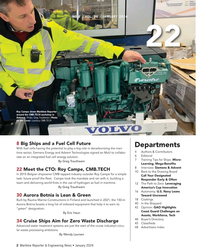 )
January 2024 - Maritime Reporter and Engineering News page: 2
)
January 2024 - Maritime Reporter and Engineering News page: 2NO.1 / VOL. 86 / JANUARY 2024 22 Roy Campe shows Maritime Reporter around the CMB.TECH workshop in Antwerp. Photo: Greg Trauthwein | Photo on the Cover: courtesy CMB.TECH 8 Big Ships and a Fuel Cell Future Departments With fuel cells having the potential to play a big role in decarbonizing the mari- 4
-
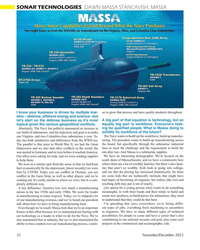 )
November 2023 - Marine Technology Reporter page: 32
)
November 2023 - Marine Technology Reporter page: 32SONAR TECHNOLOGIES DAWN MASSA STANCAVISH, MASSA ue to grow that process and have quality products throughout. I know your business is driven by multiple mar- kets – defense, offshore energy and science –but let’s start on the defense business as it’s most A big part of that equation is technology
-
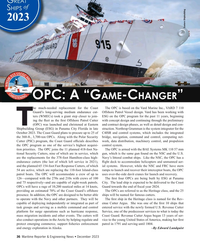 )
December 2023 - Maritime Reporter and Engineering News page: 36
)
December 2023 - Maritime Reporter and Engineering News page: 36G REAT of HIPS S 2023 Eastern Shipbuilding OPC: A “G -C ”AME HANGER he much-needed replacement for the Coast The OPC is based on the Vard Marine Inc., VARD 7 110 Guard’s long-serving medium endurance cut- Offshore Patrol Vessel design. Vard has been working with ters (WMECs) took a giant step closer
-
 )
December 2023 - Maritime Reporter and Engineering News page: 30
)
December 2023 - Maritime Reporter and Engineering News page: 30G REAT of HIPS S SHIP OWNER/OPERATOR Ship Owner Mitsui O.S.K. Lines, Ltd. 2023 Shipbuilder Oshima Shipbuilding LOA 235m Breadth 43m Deadweight About 100,422 tons Flag/Port of registry Japan/Port of Noshiro WIND CHALLENGER SPECIFICATIONS Height Up to about 53 m (4-tier) Width About 15 m Sail
-
 )
December 2023 - Maritime Reporter and Engineering News page: 13
)
December 2023 - Maritime Reporter and Engineering News page: 13the whole system will need to be decontaminated. any necessary new components. This is done in conjunction Scanunit, in partnership with compatriot Swedish company with the ship’s classi? cation society to ensure that necessary LifeClean, is offering a turnkey solution for decontaminating approvals
-
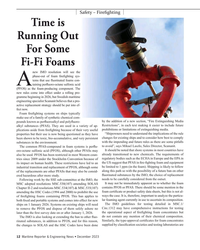 )
December 2023 - Maritime Reporter and Engineering News page: 12
)
December 2023 - Maritime Reporter and Engineering News page: 12? uoro-octane sulfonic acid (PFOS) as the foam-producing component. The new rules come into effect under a rolling pro- gramme beginning in 2026, but Swedish maritime engineering specialist Scanunit believes that a pro- active replacement strategy should be put into ef- fect now. Foam ? re? ghting systems
-
 )
November 2023 - Marine News page: 64
)
November 2023 - Marine News page: 64ADVERTISER INDEX Page Company Website Phone# 39 Ahead Sanitation www.aheadsanitationsystems.com (337) 330-4407 29 All American Marine www.AllAmericanMarine.com (360) 647-7602 49 Arcosa Marine www.arcosamarine.com (615) 400-4373 3 C Job Naval Architects c-job.com/offshore Please visit our
-
 )
November 2023 - Marine News page: 47
)
November 2023 - Marine News page: 47teries. All of this happens seamlessly through Stewart and ning, the towboat is expected to have an estimated 27% Stevenson’s power management system.” reduction in emissions compared to a conventional towing Propulsion is provided by two 575 KW Danfoss elec- vessel, the company added. tric motors that
